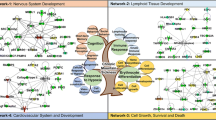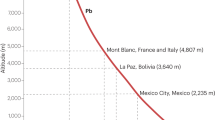Abstract
Autonomic function is altered by altitude in sojourners and natives. We hypothesized that these physiologic responses are modulated by changes in gene expression. We compared gene product levels in 20 natives of Cerro de Pasco (CP), (4338 m), 10 of which had chronic mountain sickness (CMS) established by a CMS-scoring system, with gene products in the same men after 1 h at sea level. We further compared the results with those obtained from 10 US men residing at 1500 m. We measured gene products in white cells by reverse transcription polymerase chain reaction (RT-PCR). We focused on genes important in vascular autonomic physiology, and/or activated by hypoxia; hypoxia inducible factor 1-α (HIF 1-α), 2 splicing variants of vascular endothelial growth factor (VEGF); VEGF-121, VEGF-165, and phosphoglycerate kinase 1 (PGK 1).
Normal CP natives showed high expression of all genes in CP, compared to US controls. Within 1 h of arrival at sea level, they had comparable levels to US residents. In CMS, the gene products were higher in CP. Although gene products decreased in Lima in this group, they never reached US values. VEGF 121 and 165 were correlated (P<0.001). VEGF 165 was higher in CMS in CP (P=0.006), and was positively correlated with CMS-score (R=0.86, P<0.001), and negatively correlated with arterial saturation (R=−0.79, P<0.001).
Our findings underscore the changes in gene expression levels in intact humans in response to environmental stress. These changes may support the physiologic alterations induced by the ambient hypoxia at altitude and impact organism survival. They also suggest therapeutic strategies for autonomic and neurodegenerative diseases at sea level.


Similar content being viewed by others
References
Appenzeller O, Minko T, Pozharov V, Bonfichi M, Malcovati L, Gamboa J, Bernardi L (2003) Gene expression in the Andes; relevance to neurology at sea level. J Neurol Sci 207:37–41
Claydon VE, Norcliffe LJ, Moore JP, Rivera-Ch M, Leon-Velarde F, Appenzeller O, Hainsworth R (2004) Orthostatic tolerance and blood volumes in Andean high altitude dwellers. Exp Physiol 89:565–571
Cornelussen RNM, Vanagt WYR, Prinzen FW, Snoeckx LHEH (2003) Proteins involved in salvage of the myocardium. In: Roach RC, Wagner PD, Hackett PH (eds) Hypoxia: through the lifecycle. Kluwer Academic/Plenum Publishers, New York, pp 277–291
Cuervo AM, Stefanis L, Fredenburg R, Lansbury PT, Sulzer D (2004) Impaired degradation of mutant α-synuclein by chaperone-mediated autophagy. Science 305:1292–1295
Drewes LR (2001) Molecular architecture of the brain microvasculature: perspective on blood–brain transport. J Mol Neurosci 16:7–12
Finkel T, Holbrook NJ (2000) Oxidants, oxidative stress and the biology of ageing. Nature 408:239–247
Freeman R (2003) Treatment of orthostatic hypotension. Semin Neurol 23:435–442
Goldman SA, Nedergaard M (2002) Erythropoietin strikes a new cord. Nat Med 8:495–505
Höpfl G, Ogunshola O, Gassmann M (2003) Hypoxia and high altitude. The molecular response. In: Roach RC, Wagner PD, Hackett PH (eds) Hypoxia: through the lifecycle. Kluwer Academic/Plenum Publishers, New York, pp 98–116
León-Velarde F, Ramos MA, Hernandes JA, De Idiaquez D, Munoz LS, Gaffo A, Cordova S, Durand D, Monge C (1997) The role of menopause in the development of chronic mountain sickness. Am J Physiol 272:R90–R94
León-Velarde F, McCullough RG, McCullough RE, Reeves JT (2003) Proposal for scoring severity in chronic mountain sickness (CMS). In: Roach RC, Wagner PD, Hackett PH (eds) Hypoxia: Through the lifecycle. Kluwer Academic/Plenum Publishers, New York, pp 339–354
Levine BD (2000) Mountain medicine and the autonomic nervous system. In: Appenzeller O (eds) Handbook of clinical neurology 75 (31): the autonomic nervous system. Part II Dysfunction. Elsevier, Amsterdam, pp 259–280
Lu H, Forbes RA, Verma A (2002) Hypoxia-inducible factor 1 activation by aerobic glycolysis implicates the Warburg effect in carcinogenesis. J Biol Chem 277:23111–23115
Monge MC (1925) Sobre un caso de enfermedad de Váquez. Presented at: Academia Nacional de Medicina Lima 1:1–7
Peñalosa D, Sime F, Ruiz L (1971) Cor Pulmonale in chronic mountain sickness: present concept of Monge’s disease. In: Portet R, Knight J (eds) High altitude physiology; cardiac and respiratory aspects. Churchill Livingston, Edinburgh, pp 41–60
Semenza GL (2001) Hypoxia-inducible factor 1: oxygen homeostasis and disease pathophysiology. Trends Mol Med 7:345–350
Sharp FR, Bernaudin M (2004) HIF 1 and oxygen sensing in the brain. Nat Rev Neuroscience 5:437–448
Sime F, Monge CC, Whittemburry J (1975) Age as a cause of chronic mountain sickness (Monge’s disease). Int J Biometeorol 19:93–98
Storkbaum E, Lambrechts D, Carmeliet P (2004) VEGF: once regarded as a specific angiogenic factor, now implicated in neuroprotection. Bioessays 26:943–954
Tassorelli C, Nappi RE, Blandini F, Micieli G, Nappi G (1999) Stress and the autonomic nervous system. In: Appenzeller O (eds) Handbook of clinical neurology 74 (30): the autonomic nervous system. Part I normal functions. Elsevier, Amsterdam, pp 304–349
Thomas PK, King RHM, Feng SF, Muddle JR, Workman JM, Gamboa J, Tapia R, Vargas M, Appenzeller O (2000) Neurological manifestations in chronic mountain sickness: the burning feet-burning hands syndrome. J Neurol Neurosurg Psychiatry 69:447–452
Author information
Authors and Affiliations
Corresponding author
Additional information
Funded by New Mexico Health Enhancement and Marathon Clinics Research Foundation with assistance of NIH grant # IHSEP-02
O.A. was National Science Foundation Exchange Scholar and Fogarty International Exchange Scientist
Rights and permissions
About this article
Cite this article
Appenzeller, O., Minko, T., Qualls, C. et al. Gene expression, autonomic function and chronic hypoxia:lessons from the Andes. Clin Auton Res 16, 217–222 (2006). https://doi.org/10.1007/s10286-006-0338-3
Received:
Accepted:
Published:
Issue Date:
DOI: https://doi.org/10.1007/s10286-006-0338-3




